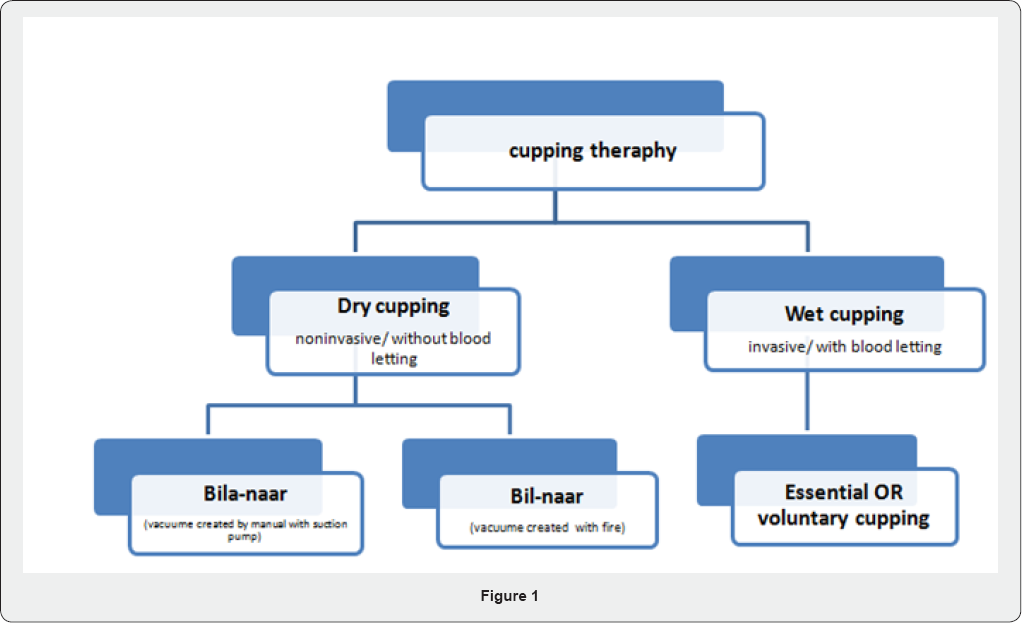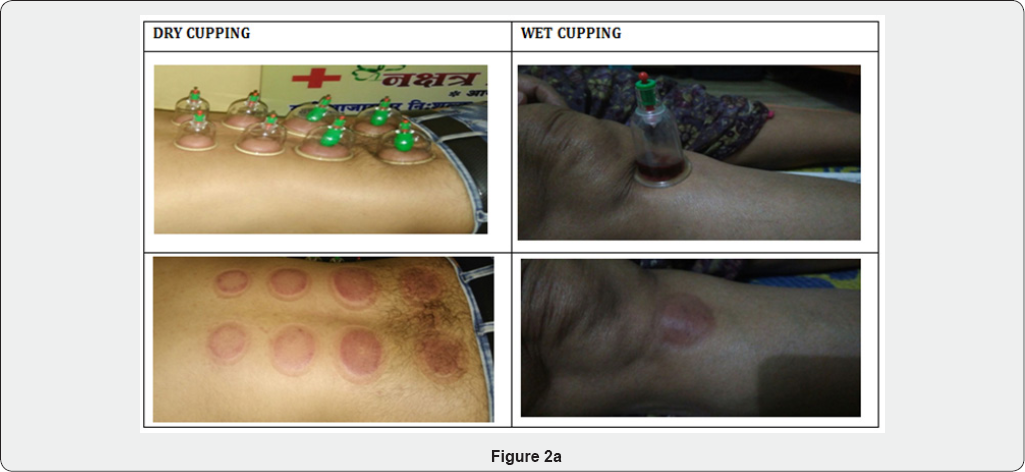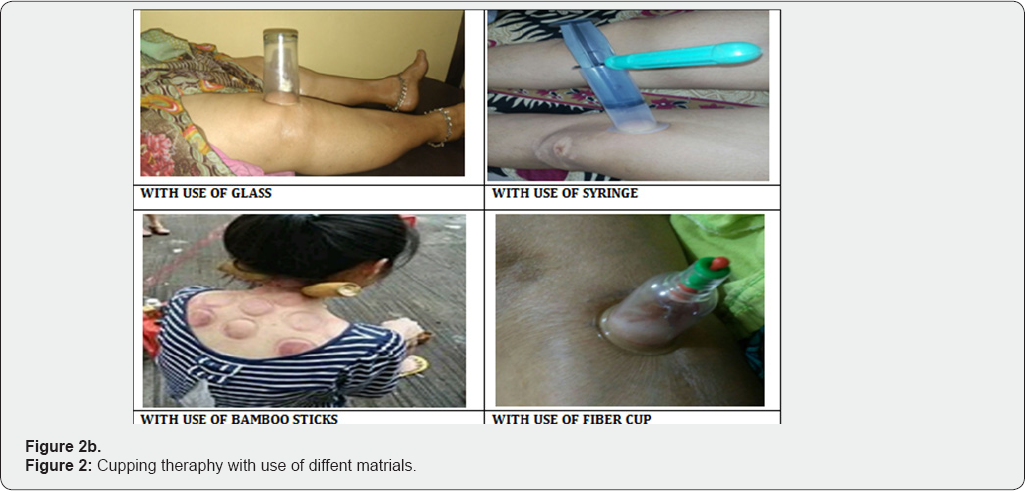Cupping Therapy: An Ancient Alternative Medicine
Dnyaneshwar K Jadhav*
Medical Director & Consulting Ayurved Physician, Nakshtra Ayurved Clinic & Research Center, Mumbai, India
Submission: March 27, 2018; Published: April 03, 2018
*Corresponding author: Dnyaneshwar K Jadhav, Medical Director & Consulting Ayurved Physician, Nakshtra Ayurved Clinic & Research Center, Mumbai, India; Tel: 8451834859; Email: dj85015@gmail.com
How to cite this article: Dnyaneshwar K J. Cupping Therapy: An Ancient Alternative Medicine. J Phy Fit Treatment & Sports. 2018; 3(1): 555601. DOI: 10.19080/JPFMTS.2018.03.555601
Abstract
Cupping therapy is a traditional therapy used from ancient era. In China, traditional medical practitioners use that therapy. Cupping removes the stagnation and stimulates the flow of chi i.e. free flow of vital energy circulating through the body and world around us. A therapeutic cupping treatment involves warming and placing cups on skin part of body which undergoing for treatment. Generally cup is made up of glass, plastic, fibres. By warming the air within the cup we create the vacuum. When we apply cup on the skin, the tissue is drawn up into the cup.
This procedure increases the blood flow, loosen the fascia and connective tissue and all of this stimulates healing. Mostly cups are placed on the back, neck and shoulder or site of pain. Cupping may cause temporary bruising and soreness depending on the degree of suction created by the vacuum and level of internal stagnation. The cups are removed by lifting one edge, which allow air in and breaks the seal and vacuum. While it use in bloodletting, it is known as hijma. This treatment successfully removed toxin and stagnation. Now days this alternative therapy become very popular. Due to easy procedure, instant relief, whole world is running toward this therapy. This review article is platform to provide basic information of cupping therapy to all Research scholar
Keywords: Cupping therapy; Hijma; Traditional therapy; Raktamokshana; Pain management
Introduction
Cupping techniques are described and can be found in the text books of TCM from over 1,000 years ago. Cupping is oldest traditional Chinese medicine procedure. In Ayurvedic Raktamokshana there is description of alabu. Basic concept of wet cupping and alabu is same. According to Ann Michelle Casco, L.A.c., classic cupping technique is called ba guan zi, which is fire or dry cupping. This involves placing the cup over anashi (painful area) point or an acupuncture point along an energy meridian [1]. Numerous athletes from the Olympics in Rio 2016 used cupping. This was easily seen by circular markings on some of the U.S. swim team members.
History of Cupping Therapy
There is reason to believe the practice dates from as early as 3000 BC. The Ebers Papyrus , written c. 1550 BC and one of the oldest medical textbooks in the Western world, describes the Egyptians ' use of cupping, while mentioning similar practices employed by Saharan Peoples. In ancient Greece, Hippocrates (c. 400 BC) used cupping for internal disease and structural problems. The method was highly recommended by Muhammad and hence well-practiced by Muslim scientists who elaborated and developed the method further. Consecutively, this method in its multiple forms spread into medicine throughout Asian and European civilizations. In China, the earliest use of cupping that is recorded is from the famous Taoist alchemist and herbalist, GeHong (281-341 A.D.). Cupping was also mentioned in Maimonides' book on health and was used within the Eastern European Jewish community [2].
Aim
Cupping therapy becomes popular day by days. Many practitioner want to practise this therapy. But very short information they fear to practise. This Review article is platform to provide basic information of cupping therapy to all Research scholar & practitioner.
Definition of cupping therapy
Cupping therapy is therapy of alternative medicine. Due to use of cups, it is called as cupping therapy. Hijma is alternative name of cupping therapy. It is Arabic word, which means 'suck'.
Types of Cupping
Different types of cups are selected according to need in the treatment, area of treatment availability. There are also different types of cups. Most commonly cups are made out of glass. However, a thousand years ago, cups were made of bamboo, clay, or animal horns [3] (Figure 1).

Method of Cupping
Massage oil is applied to the skin prior to the cups being placed, which allows the cups to glide easily over the surface of the skin With air cupping, an alternative to fire cupping, a hand held suction pump is used to remove air from the cups, creating the vacuum without heat.
Wet Cupping
A lancet is used to prick the skin before the cup is applied, which encourages a small amount of blood to flow from the area. This treatment is thought to dispel internal toxins. TCM practitioners in China use this technique for "cooling" inflammatory conditions (Figure 2).


Mechanism of Cupping Therapy
a) TCM teaches that it is the stagnation of qi and blood that causes pain and disease. Cupping invigorates local circulation of qi and blood in the area being treated, resolving swelling, pain, and tension. By drawing impurities to the surface, it removes toxins.
b) From a Western physiology perspective, cupping loosens connective tissue or fascia and stimulated blood flow to the surface. Cupping stimulates tissue relaxation and better cell-to-cell communication.
c) In case of cardiac disease, cupping shows cardio-protective action in an ischemic reperfusion injury model of rats [4].
Duration of Cupping
a) The cups are left in place anywhere from 5 to 20 minutes depending on the nature of the individual's condition.
b) A general course of treatment involves four to six sessions in intervals starting from three to 10 day gaps.
Cupping Adverse Events
Cupping therapy adverse events can be divided into local and systemic adverse events [5].
Local Adverse Events Including
a) Bruises (hematoma)
b) Marks on the skin
c) Minor to severe burns (in Fire cupping)
d) Panniculitis
e) abscess formation
f) Irritated (after treatment)
g) Pain at incision site (after treatment)
h) Infection at incision site (after treatment)
Systemic Adverse Events Including
a) Anaemia
b) Dizziness
c) Vasovagal attack
d) Insomnia
e) Headaches
f) Nausea
Indication of Cupping Therapy
a) Pain
b) Stiffness
c) Muscular spasms
d) Congestion due to trauma
e) Skin disorder
f) Digestive complaints
g) Lung disorders
h) Diseases which comes under cupping therapy are lumber disc herniation, cervical spondylitis, cough, bronchial congestion, asthma, Anxiety, paralysis, Depression, back pain, varicose veins ,high blood pressure, eczema, acne, fertility, arthritis, fibromyalgia, diabetes, anaemia, shingles (herpes zoster), insomnia, and gout [6].
Contraindication of Cupping Therapy
a) Patients with bleeding disorders such as haemophilia or who are being treated with anticoagulants, cupping may not be the best treatment option.
b) Cupping should not be performed on skin sites with active inflammation, burns, infection, and open wounds.
c) A child
d) Elderly
e) Pregnant
f) Menstruating [7].
Research on Cupping
The research of U.S. physiologist and acupuncturist Helene Langevin has documented cell-level changes using an ultrasound camera. She has demonstrated that techniques like cupping, acupuncture, and massage relax tissue and reduce markers of inflammation. Inflammatory cytokines (chemical messengers) are reduced, and cytokines that promote healing and relaxation are increased [7].
Benefits of Cupping Therapy
a) Local pain relief muscle relaxation.
b) improves overall health by removing the energy blockage
c) For athletes, cupping may help increase blood flow to a particular muscle region or help reduce pain.
Conclusion
Cupping is oldest therapy which used worldwide for different purpose. It is come under alternative medicine, which is more benefit compare to side effect. Cupping has gained publicity in modern times due to its use by American sport celebrities. Now, it's used in whole world with modification of cupping instrument. Such instrument available on Amazon site even. Aim of this review research paper is to give basic information of cupping therapy.
Acknowledgment
I am practicing Alabu therapy with glass and syringe since my graduation periods. Basic action of Alabu therapy & cupping therapy is same. In-between period I stop this therapy. I restart this therapy after contact with Dr. Ram Arora sir. Work of Dr. Ram Arora in field of cupping therapy give confidence to new practitioner like us.
References
- (2018) www.motusxfix.com/cupping.
- https://en.m.wikipedia.org/wiki/Cupping_therapy
- Chirali I (1999) cupping therapy: Traditional chinese medicine. Elsevier Health science, London.
- Shekarforoush S, Foadoddini M (2012) Cardiac effect of cupping : Myocardial infarction, arrhythmias, heart rate and mean atrial blood pressure in the rat heart. Chin J Physiol 55(4): 253-258.
- Al Bedah Abdullah, Shaban Tamer, Suhaibani Amen, Gazzaffi Ibrahim, Khalil Mohammed, et al. (2016) Safety of Cupping Therapy in Studies Conducted in Twenty One Century: A Review of Literature. British Journal of Medicine and Medical Research 15 (8): 1-12.
- Piyush Methata, Vividha Dhapane (2015) Cupping therapy: A prudent remedy for a plethora of medical ailments. Journal of traditional and complementary medicine 5(3): 127-134.
- http://www.medicinenet.com/cupping/article.htm






























